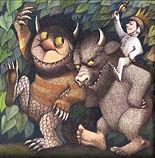An Imaginary friend, also known as imaginary companion, is a fictional character created by children. Imaginary friends may exist for the child into adolescence and sometimes adulthood.
Description
Imaginary friends often have elaborate personalities and behaviors. Although they may seem very real to their creators, studies have shown that children do have an understanding that their imaginary friends are not real.
Function
Imaginary friends often function as tutelaries (or perform a tutelary function) when they are engaged by the child in play activity.
According to several theories of psychology, an understanding of a child's conversations with their imaginary friends can reveal a lot about the anxieties and fears of that child as well as the child's aspirations and perception of the world. Some children report that their "imaginary friends" manifest themselves physically and are indistinguishable from real people, while others say that they see their friends only in their heads.
Studies
Recent research has been providing some surprising answers to some of these questions. Firstly, there is now clear evidence that imaginary friends are a common feature in childhood development.
It is now recognized that imaginary friends are often part of normal development.
A good example comes from the United States, where pre-school children and their parents took part in a 2004 study looking at different aspects of development, including imaginary companions.
The children were then followed up after starting school, when they were aged seven years. The researchers were very surprised to find that 65% of children up to age seven currently or previously had had imaginary friends.
Like other research, imaginary friends which were based on a special toy were included. In a study in the United Kingdom, 1,800 children completed a questionnaire about imaginary friends. Forty six per cent of them reported past or current imaginary friends, including nine per cent of 12-year-olds.
Art
- In the 1950 film, Harvey, the character Elwood P. Dowd, played by James Stewart, has an imaginary giant rabbit friend known as Harvey.
- In the 1991 movie Drop Dead Fred, the lead character develops an imaginary friend in order to cope with the psychological abuse that she had received from her mother.
- The film 1996 Bogus, starring Whoopi Goldberg, also deals with the issue of imaginary friends.
- The 1999 Disney film Don't Look Under the Bed is about a girl whose imaginary friend turned into a Bogeyman.
- The 2006 Australian film Opal Dream is based on a book about a young girl with two imaginary friends, Pobby and Dingan.
- In the 1980 psychological horror film The Shining, Danny has an imaginary friend named Tony who "lives in his mouth". Other characters may also have other imaginary friends, which are manifested as ghosts.
- The 2005 horror / psychological thriller film Hide and Seek, focuses on a young girl with a murderous imaginary friend.
- In Donni Darko, Frank is tipped off that the world will end in 28 days by a giant rabbit, who convinces him to commit a serious of increasingly violent acts.
- The 2009 Where the Wild Things Are is a 2009 fantasy/drama movie centers around a lonely eight-year-old boy named Max who sails away to an island inhabited by creatures known as the "Wild Things", who declare Max their king.

